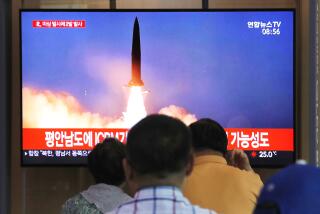America Must Face Down India
- Share via
The three nuclear tests conducted by India in the Pokharan desert Monday confirm the world’s worst fears of nuclear irresponsibility in New Delhi’s Hindu fundamentalist rulers. India’s duplicitous claims of a peaceful nuclear program have been replaced by an open admission of a nuclear weapons program. The three tests--one atomic bomb to assess fission capability, one hydrogen bomb to assess fusion capability and one low-yield device to test the miniaturization of their nuclear designs--clearly cross the weapons thresholds set by the international community at every level.
The Clinton administration’s inability thus far to control New Delhi’s thirst for nuclear power must now be met with decisive and quick moves to economically sanction and politically isolate India for its dangerous nuclear ambitions. It is no longer enough for American foreign policy and national security officials to conduct high-level diplomacy to exchange rhetorical promises with New Delhi in a region America should view as a critical flashpoint of tensions.
Ensuring stability for one quarter of all humanity is a vital U.S. security interest. It cannot be achieved unless Pakistan’s security considerations in its relationship with India are credibly addressed. The roots of South Asia’s economic revival lie in reducing the unconscionable burdens that India’s military buildup and nuclear irresponsibility impose on its neighboring countries.
At present, U.S. policy in South Asia is crafted on the premise that India can be developed into a manageable regional military and economic power and that in doing so, the U.S. will have developed an effective confrontational deterrent to China and to any future threat that Beijing poses to U.S. interests in Asia. Both premises are philosophically and factually unsound.
Developing deterrence assumes conflicting objectives and enmity exist between two sides. Despite their latent border disputes and Indian assertions to the contrary, China and India are not poised for confrontation. China is not an expansionist power. India is and has repeatedly demonstrated its thirst for expansion in the past 50 years.
Since independence in 1947, Indian expansionism has engulfed Kashmir, Junagarh, Hyderabad, Goa and Sikkim. Hegemonic tendencies are ingrained in the Indian psyche. New Delhi cannot, for example, claim constructive relations with a single one of its six neighbors: Bangladesh, Bhutan, the Maldives, Nepal, Pakistan and Sri Lanka.
This assertiveness flows from India’s peculiar vision of South Asia. While India’s neighbors see the region as a normal grouping of independent states, India views the region as a unified “Indian” subcontinent over which it has manifest destiny to play the dominant role. This is why India continues to view Pakistan as a transient phenomenon, a pimple if you will on the face of Mother India that must be smoothed over and reassimilated to restore her facial beauty.
Credit India, however, with mastering the art of dissimulation (not surprising in a country that has named New Delhi’s diplomatic enclave “Chanakyapuri” after the Hindu philosopher who defined diplomacy as the art of deception in his writings more than 2,000 years ago). It is this dissimulation that has been used to create the specter of a nonexistent Chinese threat as the justification for India’s destabilizing nuclear and conventional military buildup.
The center of gravity in South Asian security considerations lies in India, not in China. Once this is understood, the potential for a remarkably clear and articulate U.S. policy to be developed is greatly enhanced. It is time for the U.S. to involve itself in three critical ways:
First, the U.S. must bluntly tell India, in the same way it has told Iraq in the past, that the reckless nuclear path on which it has embarked contains the germs of economic disaster not only for India, but for the entire region.
Second, the limp efforts of the U.S. to date must be replaced with more plausible and concerted intervention to reduce the level of conventional and nuclear armaments. Over the past three decades, Pakistan has made a number of proposals to India, including simultaneous signatures on the Nonproliferation Treaty, bilateral International Atomic Energy Agency safeguards and a nuclear weapons free zone for the region. India has remained totally nonresponsive.
Third, America must find the political courage, as it did finally in Bosnia, in Northern Ireland and on the Korean Peninsula, to insert itself meaningfully into South Asia’s security dialogue by offering concrete solutions to end the Indian occupation of Kashmir in accordance with U.N. Security Council resolutions.
Only with the personal intervention of the free world’s leader can the region be extracted from its tragic morass to fulfill its promise of economic prosperity.
More to Read
Sign up for Essential California
The most important California stories and recommendations in your inbox every morning.
You may occasionally receive promotional content from the Los Angeles Times.













